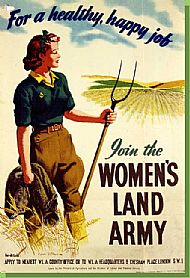Sandy's Blog
Cromarty Women in Wartime
by Casagrandeblog - 09:22 on 24 June 2013
That was an enjoyable ‘Memories’ session on Cromarty Church Life last Thursday - you can see a summary of the discussion on the News and Reports page. But if you don’t mind, I would like to go back one more time to the theme of Cromarty at War. It occurs to me that almost all our discussions about the First and Second World Wars have been about men. The women of Cromarty haven’t had much of a look in. What were the women doing during the two World Wars? Some of them may have been Land Girls. Were any of them munitions workers - working in Glasgow factories or in the Rose Street Foundry in Inverness? Did any sign up to be nurses on the front line?
What were the women doing during the two World Wars? Some of them may have been Land Girls. Were any of them munitions workers - working in Glasgow factories or in the Rose Street Foundry in Inverness? Did any sign up to be nurses on the front line?
An article in the current issue of ‘History Scotland’ magazine looks at the role of Scottish women in the Great War. It tells of the needlework parties of Orkney, knitting socks to be sent to the Front. But what struck me was the fate of the hundreds of fisher lassies who used to follow the herring fleets round the country. After the North Sea fishing fleet was bombed in 1915, more than 500 of these women took up munitions work. There were so many working in Glasgow that the Highland Girls Club for Munitions Workers was established in 1916 in West George Street.
 This was a church initiative, and it seems that the churches - and not only the churches - were worried about the effect of the war on female morals. Young women were becoming infected with ‘khaki fever’ and finding morally dubious ways to express their patriotism. This was a real problem in Inverness, in the Merkinch, where the burgh school had a large US Navy base in the field next door. The school log book reports that the older girl pupils were now receiving ‘special lectures on Hygiene, Personal Cleanliness and Purity, with marked success’.
This was a church initiative, and it seems that the churches - and not only the churches - were worried about the effect of the war on female morals. Young women were becoming infected with ‘khaki fever’ and finding morally dubious ways to express their patriotism. This was a real problem in Inverness, in the Merkinch, where the burgh school had a large US Navy base in the field next door. The school log book reports that the older girl pupils were now receiving ‘special lectures on Hygiene, Personal Cleanliness and Purity, with marked success’.
An organisation of middle-class women, misleadingly called the National Union of Women Workers, began organising Women’s Patrols in districts with large numbers of troops. Women aged between 27 and 50 would patrol in pairs in distinctive armlets and badges. Finding a girl with a soldier, they would persuade her to return home. The Chief Constable responsible for Elgin saw the patrols as an ideal way of addressing the ‘swarms of young girls who are constantly molesting the soldiers’.
So - what was happening in Cromarty? Were our young women ‘molesting’ the soldiers? Did anyone care? I think we should be told.
Add your comment
